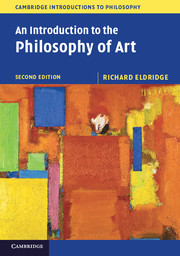Book contents
- Frontmatter
- Contents
- Acknowledgments
- Preface to the second edition
- 1 The situation and tasks of the philosophy of art
- 2 Representation, imitation, and resemblance
- 3 Beauty and form
- 4 Expression
- 5 Originality and imagination
- 6 Understanding art
- 7 Identifying and evaluating art
- 8 Art and emotion
- 9 Art and morality
- 10 Art and society: some contemporary practices of art
- 11 Epilogue: the evidence of things not seen
- Bibliography
- Index
- References
2 - Representation, imitation, and resemblance
Published online by Cambridge University Press: 05 June 2014
- Frontmatter
- Contents
- Acknowledgments
- Preface to the second edition
- 1 The situation and tasks of the philosophy of art
- 2 Representation, imitation, and resemblance
- 3 Beauty and form
- 4 Expression
- 5 Originality and imagination
- 6 Understanding art
- 7 Identifying and evaluating art
- 8 Art and emotion
- 9 Art and morality
- 10 Art and society: some contemporary practices of art
- 11 Epilogue: the evidence of things not seen
- Bibliography
- Index
- References
Summary
Representation and aboutness
Art products and performances seem in some rough sense to be about something. Even when they do not carry any explicitly statable single message, they nonetheless invite and focus thought. Marcel Duchamp’s readymades, Sol Le Witt’s constructions, Vito Acconci’s performance pieces, and Louise Lawler’s conceptual art are all put forward, in Duchamp’s phrase, “at the service of the mind,” in that they are intended to set up in an audience a line of thinking about a subject matter. Most literary works clearly undertake to describe an action, situation, or event. Works of dance typically have a narrative-developmental structure, and even works of architecture seem both to proceed from and to invite thoughts about how space is and ought to be experienced and used. Works of textless pure or absolute music have beginnings, middles, and ends that have seemed to many listeners to model or share shapes with broad patterns of human action. The abstract painter Hans Hoffmann in teaching used to have his students begin by putting a blue brush stroke on a bare canvas and then asking them to think about its relations to the space “behind,” “in front of,” and around it, as though the mere stroke were already a means of incipiently presenting a three-dimensional world on a two-dimensional surface.
Yet these facts about presentation of a subject matter in the arts raise considerable problems. How is representation achieved in various media? Does representation centrally involve any likeness or resemblance (as seems to be the case in much visual depiction) between representer and represented, or does it involve centrally the manipulation of syntactically structured conventional codes (as in linguistic representation)? Is the same sense of “representation” (with different means of achieving it) involved in different media of art? Does the value of a work of art depend upon what it represents, and if so, how? Is representationality even necessary for art? Is it sufficient?
- Type
- Chapter
- Information
- An Introduction to the Philosophy of Art , pp. 25 - 52Publisher: Cambridge University PressPrint publication year: 2014

